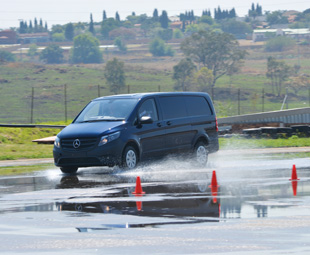Big on choice

GAVIN MYERS drove the all-new Vito at launch and found it to be a little confusing
There was, in fact, much confusion at the launch of Mercedes-Benz’s new Vito, during mid-September. You see, the new range consists of four diesel engine options, denoted 111, 114, 116 and 119; either front- or rear-wheel drive and a six-speed manual or seven-speed automatic gearbox; three body styles, of Panel Van, Mixto and Tourer; and two spec levels – Pro and Select.
There’s more … The all-new front-wheel drive setup is only available with the base 1,6-litre 111 engine (the other three engines being of 2,2-litre capacity), while the Pro and Select spec levels are only available on the Tourer.
The choice is mind-boggling at first – as is the catalogue of accessories – so, best to drive them all to get things properly figured out!
Let’s begin by looking at the body styles. The Panel Van is claimed to have the highest payload in its class, of 1 344 kg. The front-wheel drive versions benefit from 120 kg more payload than those fitted with the heavier rear-wheel drive setup.
The van is accessed by side sliding doors and rear swing doors that open up to 180° without the need to release any additional catch.
The Mixto version offers seating for five together with loading space, accessed by a rising rear tailgate. Along the floor of the Mixto’s load compartment are rails to which a number of accessories can be fitted.
The Tourer version is the full people mover. In the Pro variant it is fitted with the three-seat front bench of the Mixto and Panel Van (which is, unfathomably, fixed in position) for a total of nine seats. In Select spec you get individual front seats.
Mercedes-Benz has updated the interior of the Vito with an uncluttered, ergonomic design. While the overall design is pleasing, it is overly sombre with the swathes of black plastic that do appear a bit cheap – even compared to the previous model. Unfortunately, different rattles in the cabins of numerous models we drove didn’t help initial impressions of quality.
Ignoring the non-adjustable passenger bench on some models, the independent suspension all round results in a comfortable ride and good on-road dynamics.
At the Zwartkops Raceway skidpan, Mercedes-Benz was keen to show us exactly how controllable the new Vito is in emergency situations. The range now features Electronic Stability Control as standard and each model reacts confidently and safely to emergency inputs.
Back to the on-road driving; the 84, 100, 120 and 140 kW motors each provide strong, refined performance both on the open road and in town. I did not get a chance to sample the 7G Tronic automatic transmission, but the six-speed manuals are well matched to their respective powertrains. One was, unfortunately, stubborn with the engagement of its fifth and sixth ratios, requiring consistent double declutching to shift into these.
Mercedes has paid close attention to running costs with the all new Vito. Fuel consumption is said to be as low as 5,7 l/100 km on the Vito 116 CDI BlueEFFICIENCY, for example, while service intervals are set at a staggering 40 000 km. A five-year/120 000 km service plan is available on Mixto and Tourer variants.
Pricing begins at R372 780 for the 111 CDI Panel Van and goes up to an eye-watering R744 386 for the 119 CDI Tourer Select.
There’s no doubting the sheer choice presented by the new Vito, and that it is quite good on the road with its new range of engines and comfortable, confidence-inspiring ride.
At these prices, though, I hope the niggles experienced on the launch were exclusive to these early models. I look forward to spending more time with the new Vito to find out – and to put my confusion to rest.
Published by
Focus on Transport
focusmagsa




